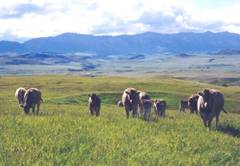|
Our History |
|
†††† In 1973, we purchased our first ranch property near Clearwater, in the interior of British Columbia, Canada.† We were interested in the idea of maximizing commercial returns in cattle production through genetic mixing.† An animal geneticist advised us that one of the best prospective genetic pools for such a breed ing program came from the European Brown Swiss, which had recently been re-introduced into Canada in its dual purpose (beef/milk) form.† This, of course, was Braun vieh as we know it today. †††† We began searching for individuals of this unique breed in western Canada.† We saw Grober/Termin offspring as well as Ueli himself and decided to incorporate Braunvieh into our own herd.† This began with the purchase of two full-blooded Braunvieh heifers and shortly thereafter, some U.S. American imported cows, pasture bred to Warren, and a few Jordan heifers.† That winter our search for a bull lead us to a choice between one of Willabarís young bulls and Warren.† Although Warren was a proven bull, we decided on the 18-month old Willabar Bouncer.† He was purchased with Starline Braunvieh (Florian Eberl and George Ulrich).† Ultimately, Willabar Bouncer was sold to Mexico, where he became National Grand Champion.† Bouncerís progeny can be found in many North American Braunvieh herds. †††† Our jobs moved us to a few different communities (including Enderby, B.C.) causing us to disperse three good base herds.† Many of these animals were sold through Starline Braunvieh or were exported out of the country.† With the next generation keen to continue the Maranatha Braunvieh operation, we made a final move in 1997 to Cowley in Southern Alberta, Canada. †††† Lori and I have personally witnessed great changes and improvements in Canadian Braunvieh cattle.† We are fortunate to possess most of the past genetics imported into Canada and retain some genetics that are unique and not readily available.† For example, we owned Melede Darcy (a son of Grober) and Silverwood Dragon and have exclusive rights to Dragonís semen in Canada.† We feel our genetic and phenotypic diversity are of interest to breeders worldwide and would gladly respond to any requests for specific information.
†††††††††††††††††††††††††††††††††††††††††††††††††††††††††††† Bruce Anderson |
